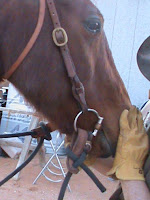I was watching Julie Goodnight the other night (on RFD TV) as she was helping one of her student-instructors get a horse sacked out on opening gates, and I heard Julie say words to the effect that it had been awhile since she (Julie) last attended a clinic. Then she explained that she likes to attend other trainer's clinics to keep herself from getting stale, and that she believes a person can and should learn from everyone. I wonder if Julie knew how important it was for her to say that as it shows not only a humble approach to her horsemanship, but it highlights the most basic of often forgotten requirements to continue evolving your horsemanship, and that is keep an open mind.
We all have our favorite trainers. They are our favorite because they have a way of presenting the concepts or the how's to do something that gets through to us. We have all probably seen students who's redundant reply to an instructor or clinician is "Yeah, but..." as they try to explain why they aren't listening to the instruction. If you follow Julie Goodnight's advice to continue to seek knowledge, and be the best student you can, you can not only expedite your journey to becoming a horseman but it will most likely save (some) pain and suffering along the way.
In the interest of passing information on notable trainers, I ran across a gent named Ross Jacobs in the Eclectic Horseman magazine edition #63, Jan-Feb 2012. Interesting article on this Australian based horse trainer. Ross maintains a pretty good website and horse owners may want to look it up. Instructional videos are available (at a cost) but there is other free information as well,....if you can do the translation, as they ain't exactly speaking American down there. Ross Jacobs is below at left.
www.goodhorsemanship.com.au
If you haven't heard of Eclectic Horseman magazine, you can see what they have to offer at http://eclectic-horseman.com//










